
3728
.pdfIssue № 4 (40), 2018 |
ISSN 2542-0526 |
A very important role in increasing the stability of highway structures is played by protection and strengthening of embankment and hollow slopes. There are different ways of strengthening slopes: grass sowing, gravel filling, strengthening with concrete plates, etc. These methods have a number of advantages and disadvantages including material and operational costs, technological effectiveness, life cycle, easy maintenance. The most optimal ones in terms of their positive and negative properties are polyurethane gravel layers. This structure started being used not long ago but has already become very widely used. A polyurethane binder is formed by mixing two components – resin and solidifier. After the components have been mixed, a polyurethane binder is poured onto gravel and solidifies forming a strong carcass structure [14—20].
The main purpose is to identify the characteristics of the interaction between a polyurethane binder and gravel of different brands and fractions. It is necessary to evaluate a polyurethane gravel layer employed for strengthening embankment and hollow slopes. An experiment to determine macroroughness of a surfacing was also conducted to investigate the possibility of using a binder for surfacing and bus pockets on highways [6].
1. Study of the adhesion of gravel (adhesive activity). Adhesive activity of gravel to a binder is evaluated by means of adhesion with a gravel surface according to the GOST (ГОСТ) 12801-98. A mass proportion in gravel of pulverescent and clayous particles is less than 1,0 % and defined by decantation. The content of clay in the form of lumps and random clogging impurities is not acceptable. The adhesion index of a binder and gravel is determined on gravel particles of more than 10 mm. A visually identified value of the gravel surface that retains a film of a binder following boiling in water is assumed to be an adhesion index.
The adhesion is determined in the following sequence:
––a gravel particle is bound with a thread or thin wire, heated in a thermostat for an hour to the temperature of 150—170 °С;
––gravels are submerged for 15 sec into a bowl with a ground binder (bitumen) to the temperature 140—160 °С;
––the remaining gravel is submerged for 15 sec into a bowl with the polyurethane mix;
––after 15 min gravels are submerged into a pan with boiling distilled water (gravels should not touch the walls or two glasses);
––after 30 min of boiling the strength of adhesion with the gravel surface is evaluated without lifting it out of the water;
––adhesion is evaluated according to Table 1.
Tests of polyurethane as a binder are performed in the same manner replacing a bitumen binder for a polyurethane one.
51
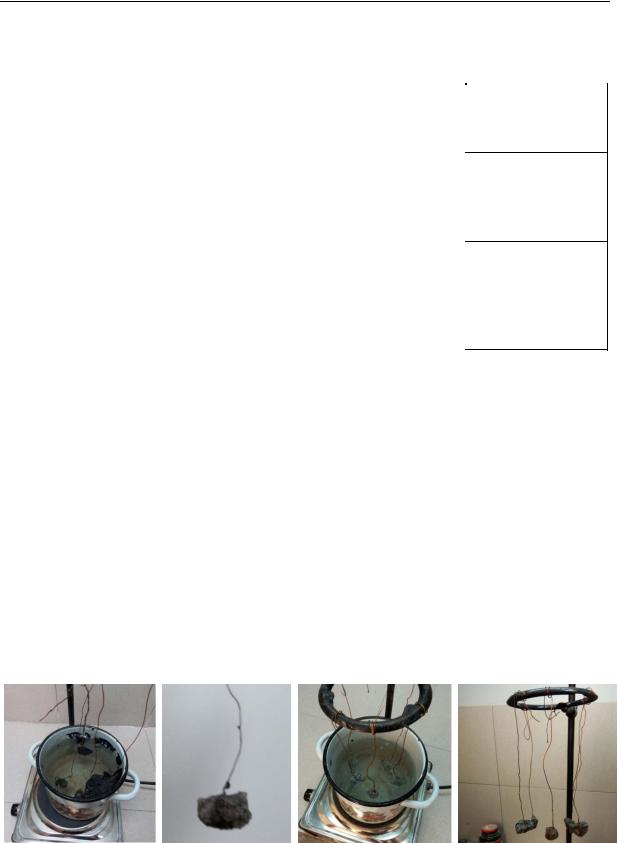
Russian Journal of Building Construction and Architecture
Таble 1
Characteristics of a film binder on the gravel surface
Clean and washed gravel |
Gravel in a natural condition |
|
|
A film of a binder is completely |
A film of a binder is completely retained: |
retained |
water is absolutely pure |
|
|
A film of a binder is exfoliated |
A film of a binder is significantly exfoliated us- |
using water. Some grains or indi- |
ing water. Large grains (50 %) are exposed and |
vidual areas (about 50 %) are |
water is a bit blurred due to washing-out of some |
exposed |
of the small fraction |
|
|
A film of a binder is completely |
A film of a binder is mostly or completely exfoli- |
exfoliated with water. The sur- |
ated with water. The mix becomes significantly |
face with small drops of the clot- |
lighter with some drops of the clotted and float- |
ted binder is almost completely |
ing binder and water growing increasingly |
exposed or floating |
blurred |
|
|
Visual adhesion indices Good
Satisfactory
Poor
In order to determine the adhesion of gravel, М1000 limestone gravel and М1200 granite gravel with bitumen as well as polyurethane binders.
The gravel was washed under running water in a sink and dried in a drying cabinet. The limestone and granite gravel with a bitumen binder was placed into a vessel with water boiling on a stove and kept in the water for 30 min. Similarly, the limestone and granite gravel with a polyurethane binder was kept in water. The stages of determining the adhesion degree of limestone with different binding materials are shown in Fig. 1. The granite gravel did not withstand the adhesion with a bitumen binder (it was floating on the surface of the water). The gravel limestone withstood an adhesion experiment based on sample № 1. The granite and limestone gravel withstood an adhesion test with polyurethane based on sample № 1.
а) |
b) |
c) |
d) |
Fig. 1. Adhesion test of the granite and limestone gravel:
а) granite gravel with a bitumen binder; b) limestone gravel with a bitumen binder;
c) granite gravel with a polyurethane binder; d) limestone gravel with a polyurethane binder
52
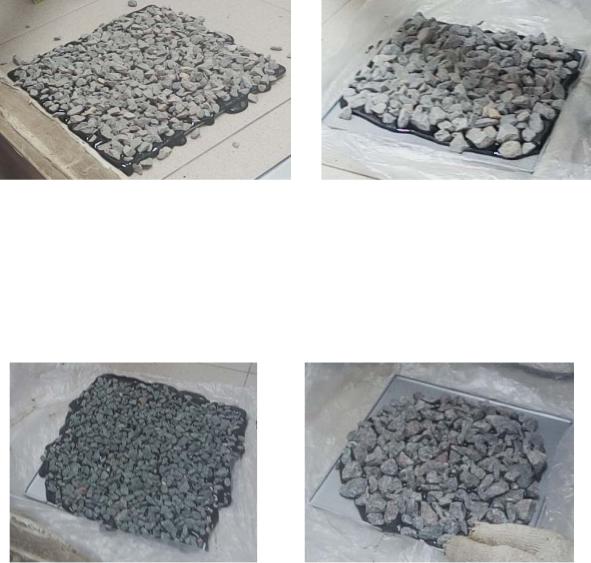
Issue № 4 (40), 2018 |
ISSN 2542-0526 |
2. Evaluation of the adhesion of a binder and stone material in a laboratory setting using a Vialit tool. М1000 limestone gravel with the fraction of 5—10 and 10—20 mm with a mass of 1 kilogram is washed and dried. М1200 granite gravel is prepared in the same manner.
Hot bitumen with the temperature of no less than 160 оС is poured into a standard metal square form of a Vialit tool. The bitumen consumption per an area unit is the same as for a standard consumption for rough surface treatment (1.0 l/m2). There are eight such metal square forms in the test.
М1000 gravel with the fraction of 5—10 mm is spilled on a preliminarily riped bitumen binder with a thin layer on the first form. The second form is prepared in the same manner using М1000 gravel with the fraction of 10—20 mm (Fig. 2).
а) |
b) |
Fig. 2. Samples of М1000 limestone gravel with the fraction of 5—10 (а) and 10—20 mm (b) with a bitumen binder
A bitumen binder is also poured onto the next two forms and М1200 granite limestone with the fraction of 5—10 is spilled (for the third form) and of 10—20 mm (for the fourth form) as shown in Fig. 3.
а) |
b) |
Fig. 3. Samples of М1200 granite gravel with the fraction of 5—10 (а) and 10—20 mm (b) with a bitumen binder
53
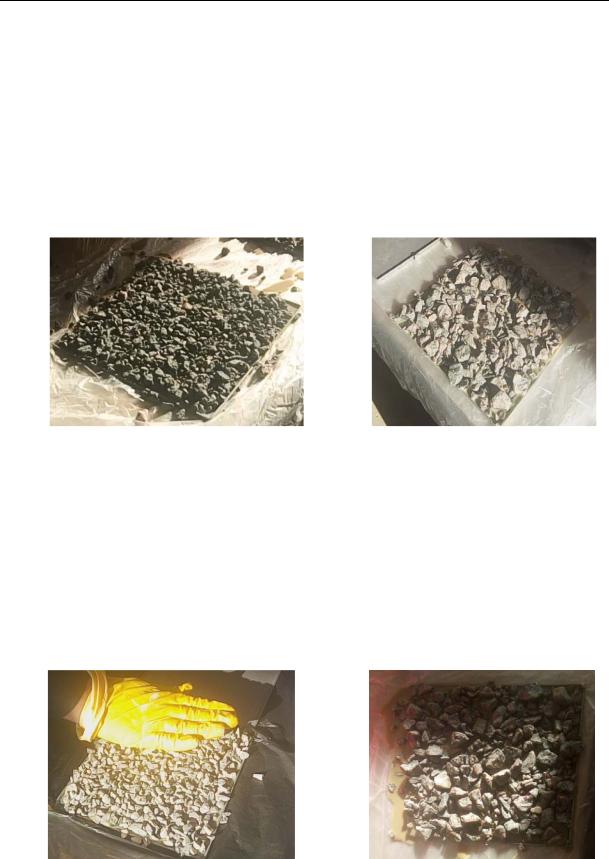
Russian Journal of Building Construction and Architecture
A polyurethane binder is prepared. A polyurethane resin RC-ТPI 001А is prepared with a construction mixer in a barrel. After that according to “The Organization Standard” (СТО) 88902325-01-2014 “Binding Material Based on Polyurethane for Highways and Artificial Structures. Technical Conditions” the resin is mixed with a solidifier in a vessel.
On the fifth form a polyurethane binder is poured in a thin layer. М1000 limestone gravel with the fraction of 5—10 mm is spilled in one layer as shown in Fig. 4. The sixth form is prepared in the same way as the fifth one and limestone with the same fraction of 10—20 mm is used.
а) |
b) |
Fig. 4. Samples of М1000 limestone gravel with the fraction of 5—10 (а) and 10—20 mm (b) with a polyurethane binder
The next two forms are prepared. A polyurethane binder is spilled in a thin layer onto the forms, М1200 granite gravel with the fraction of 5—10 is spilled in one layer (for the seventh form) and of 10—20 mm (for the eighth one) as shown in Fig. 5.
One waits for a day till the bitumen binder cools down and the polyurethane binder is bound in all the samples. Then each sample is tested on a Vialit tool (Fig. 6).
а) |
b) |
Fig. 5. Samples of М1200 granite gravel with the fraction of 5—10 (а) and 10—20 mm (b) with a polyurethane binder
54
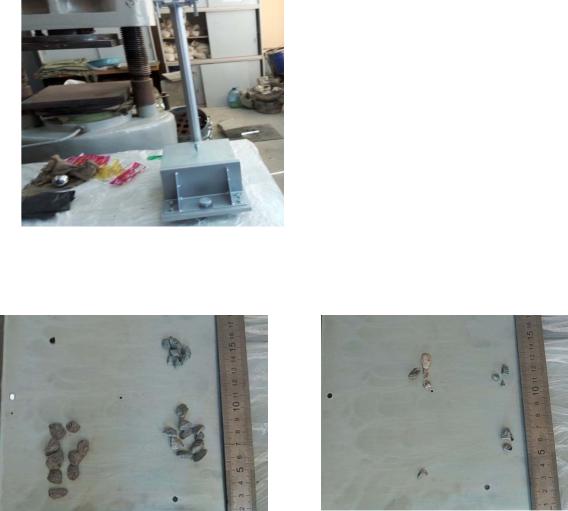
Issue № 4 (40), 2018 |
ISSN 2542-0526 |
Each sample is placed on the tool one by one where a metal ball is dropped on it according to the height.
Fig. 6. Vialit tool
Thenumberofthetorngravels(Fig.7)iscounted.ThedataisenteredintoTable2.
а) |
b) |
Fig. 7. Number of gravels torn off the tested samples:
а) samples of gravel with a bitumen binder; b) samples with a polyurethane binder
Таble 2
Results of the correlation tests on the Vialit tool according to how the gravels are torn off the layer of the binder
|
|
|
|
Gravel |
|
|
|
|
|
|
|
|
|
|
|
Binder |
|
Granite |
|
|
Limestone |
||
|
|
|
|
|
|
|
|
|
Fraction |
|
Fraction |
|
Fraction |
|
Fraction |
|
of 5—10 mm |
|
of 10—20 mm |
|
of 5—10 mm |
|
of 10—20 mm |
|
|
|
|
|
|
|
|
Bitumen |
7 |
|
10 |
|
1 |
|
9 |
|
|
|
|
|
|
|
|
Polyurethane |
4 |
|
3 |
|
1 |
|
1 |
|
|
|
|
|
|
|
|
55

Russian Journal of Building Construction and Architecture
3. Determining the average depth of macroroughness hollows (rough surface treatment) by means of the “sandy spot” method. The method allows one to determine the average depth of hollows of a rough surface of roadway surfacing as well as that with a treated rough surface. Through the course of the measurement a specified volume of sand is distributed on a surface with a rough surface treatment and using the obtained sizes of a sandy spot, the depth of hollows of a rough surface is identified.
The measurement should be conducted in the following sequence:
1)a surface is cleaned with a sweeping brush;
2)a vessel is filled with sand, the bottom of the vessel is slightly slapped for the sand to heave so that there is more sand;
3)the sand is piled on top of the surfacing;
4)the sand is distributed along the surface in circular movements till it touches the lower part of the protruding surface and the hollows are filled with the sand;
5)the diameter of the circle obtained as result of the distribution (no less than four values) is measured.
After the necessary data is obtained, it is processed. The area of the circle (a sandy spot) is given by the formula:
|
d 2 |
|
||
Sn |
ср |
, |
(1) |
|
4 |
||||
|
|
|
||
where Sn is the area of the circle, mm2; dcp is the average diameter of the circle, mm. The depth of the hollows of a rough surface is determined using the formula:
Hсрj |
1000 Vsand |
, |
(2) |
|
|||
|
Sn |
|
|
where Нсрj is the depth of the hollows of a rough surface of the j-th measurement, mm; 1000 is a conversion coefficient from cm3 into mm3; Vsand is the volume of sand spilled onto the surface, Vsand is from 200 to 250 сm3.
The sample of the materials and anti-skid surfacing are prepared using polyurethane and limestone mixes for tests.
Before starting the tests, gravel fractions of 5—10 and 10—20 mm and a polyurethane binder are prepared. In order to prepare gravel samples for the tests, they are washed in order to remove pulverescent, clayous and other impurities (Fig. 8). After all the impurities have been washed and all the gravel particles have been removed, each weighed portion is dried separately on a stove in a dry box till water is completely removed (Fig. 9).
56
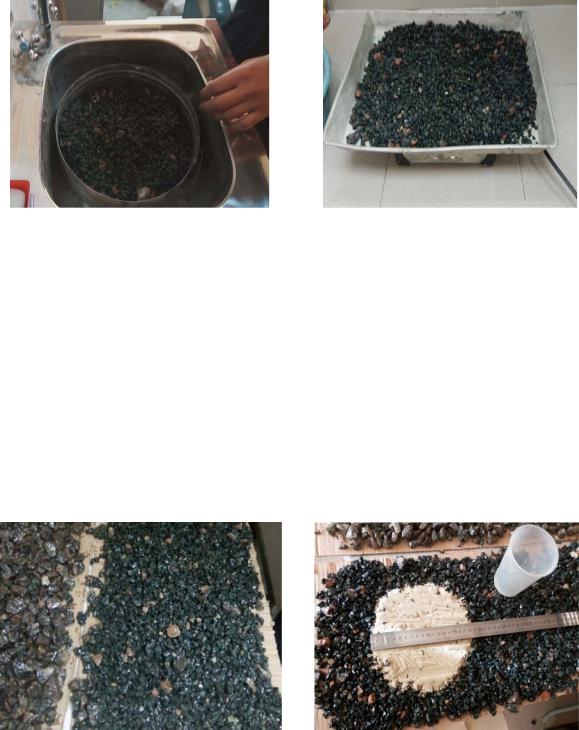
Issue № 4 (40), 2018 |
ISSN 2542-0526 |
We obtain a mix for covering the tested samples. We mix the polyurethane resin RC-ТPI 001А with a construction mixer in a barrel. Then in a special vessel the resin RC-ТPI 001А and the solidifier RC-ТPI 001B are mixed in the ratio specified in “The Organization Standard” (СТО) 88902325-01-2014.
Fig. 8. Washing of the gravel samples |
Fig. 9. Drying of the gravel samples |
After the components have been mixed with the polyurethane binder in a vessel, gravel with the fraction of 5—10 mm is spilled in small amounts and evenly mixed with the mix. The volume of the polyurethane binder is 330 ml per 5 kg of gravel. A mix of the polyurethane binder and gravel with the fraction of 10—20 mm is prepared in the same manner. The polyurethane and gravel mix with the fractions 5—10 and 10—20 mm is placed onto the carton foundations sized 100 × 30 сm (Fig. 10).
One waits for a day till the polyurethane binder is bound. Then the sand with the volume of 200 сm3 is distributed along the top of the macrorough surface (Fig. 11).
Fig. 10. Samples of the laid gravel |
Fig. 11. Distribution of sand on the samples |
57

Russian Journal of Building Construction and Architecture
The diameter of the sandy spot for the macrorough surface based on the fraction of the gravel of 5—10 mm was 19.0 сm.
The area of the circle (sandy spot) was determined using the formula (1): Sn = 28697 mm2. The depth of the hollows of a rough surface is found according to the formula (2): Нсрj = 6.97 mm.
The diameter of the sandy spot for the macrorough surface based on the gravel fraction of 10—20 mm was 13.5 сm.
The area of the circle (sandy spot) according to the formula (1) is Sn = 14306 mm2.
The depth of the hollows of the rough surface according to the formula (2) is Нсрj = 1399 mm. The obtained depth of the roughness hollows of the surface is compared with a minimum acceptable values according to “The Building Standards and Regulations” (СНиП) 3.06.03-85 and 2.05.02-85.
Conclusions
1.During the experiment to study the adhesion of a binder with gravel it was found that while testing the adhesion of a granite and limestone gravel with a polyurethane binder, a film is retained and water is pure and the visual adhesion index is high. This means that granite and limestone gravel withstood the adhesion test on sample № 1.
2.During the adhesion experiment using a Vialit tool it was found that the amount of torn gravel particles on the samples with a polyurethane binder is smaller than on those with bitumen. This indicates that there is a much better adhesion between gravel particles and a polyurethane binder.
3.The obtained macroroughness index showed that a polyurethane gravel layer with the fraction of 5—10 mm can be classed into significantly rough surfacings according to “Departmental Construction Regulations” (ВСН) 38-90 “Technical Specifications for Roadway Surfacing with a Rough Surface” and a polyurethane gravel layer with the gravel fraction of 10—20 cannot be classed into this type of surfacing due to a high depth index of a roughness surface.
4.The investigated layer can be used as a reinforcement of the edge of Class 5 roads but more detailed studies of other indices are required for final conclusions to be made.
References
1. Belyatskiy V. N., Krivoguz Yu. M. Osobennosti otverzhdeniya oligomernykh produktov iz otkhodov poliuretanov i ikh primenenie na praktike [Features of curing of the oligomeric products of polyurethane wastes and their application in practice]. Nauka i tekhnika, 2012, no. 2, pp. 68—70.
58
Issue № 4 (40), 2018 |
ISSN 2542-0526 |
2.Zadiraka A. A. Preimushchestva primeneniya poliuretanovykh kompozitnykh sostavov pri ukreplenii otkosov nasypey i vyemok v dorozhnom stroitel'stve [Advantages of the use of polyurethane composite compositions in strengthening the slopes of embankments and pits in road construction]. Vestnik Belgorodskogo gosudarstvennogo tekhnologicheskogo universiteta im. V. G. Shukhova, 2017, no. 9, pp. 25—29.
3.Zadiraka A. A. Primenenie poliuretanovykh kompozitnykh sostavov dlya ustroystva osnovaniy i/ili pokrytiy transportnykh sooruzheniy [Application of polyurethane composite compositions for the construction of bases and / or coatings of transport facilities]. Vestnik Belgorodskogo gosudarstvennogo tekhnologicheskogo universiteta im. V. G. Shukhova, 2017, no. 4, pp. 72—75.
4.Zadiraka A. A. Remont shchebenochnykh konstruktsiy na otkosakh avtomobil'nykh dorog s primeneniem sovremennykh materialov [Repair of crushed stone structures on the slopes of roads with the use of modern materials]. Tekhnicheskoe regulirovanie v transportnom stroitel'stve, 2017, no. 2 (22), pp. 1—3. Available at: http://trts.esrae.ru/41-247.
5.Zadiraka A. A., Kokodeeva N. E., Bondar' E. S. Fiziko-mekhanicheskie pokazateli i svoystva poliuretana i primenenie poliuretanovykh izdeliy, uvelichivayushchie nadezhnost' transportnykh sooruzheniy v protsesse ekspluatatsii [Physical and mechanical characteristics and properties of polyurethane and the use of polyurethane products that increase the reliability of transport facilities during operation]. Tekhnicheskoe regulirovanie v transportnom stroitel'stve, 2017, no. 6 (26), pp. 27—31. Available at: http://trts.esrae.ru/46-335.
6.Kokodeeva N. E., Kochetkov A. V., Leont'ev V. Yu. Konstruktsiya pokrytiya transportnogo sooruzheniya
[Construction of the covering of the transport structure]. Patent RF, 2015, № 155397.
7.Kokodeeva N. E., Kochetkov A. V., Leont'ev V. Yu. Sposob ustroystva konstruktsii osnovaniya i/ili pokrytiya transportnogo sooruzheniya [Method of construction of the base and / or coating of the transport structure]. Patent RF, 2016, № 2593506.
8.Leont'ev V. Yu., Kochetkov A. V., Yankovskiy L. V., Zadvornov V. Yu., Shashkov I. G. Metodika rascheta ugla osypaniya sklonov metodom izlishnikh figur pri proektirovanii zashchitnykh shchebenochnopoliuretanovykh sloev [The method of calculation of the angle of slope shedding by the method of excessive figures in the design of protective crushed stone-polyurethane layers]. Dorogi i mosty, 2016, no. 2, pp. 51—66. Available at: http://rosdornii.ru/files/dorogi-i-mosti/36/4.pdf.
9.Leont'ev V. Yu., Kokodeeva N. E. Metody remonta shchebenochnykh konstruktsiy, armirovannykh ob"emnymi georeshetkami na konusakh mostovykh sooruzheniy i otkosakh avtomobil'nykh dorog [Repair methods crushed stone constructions, reinforced surround geogrid on cones of bridges and the road slopes]. Dorogi. Innovatsii v stroitel'stve, 2015, no. 43, pp. 74—78.
10.Leont'ev V. Yu. Poliuretanovye pokrytiya [Polyurethane coating]. Avtomobil'nye dorogi, 2016, no. 5, pp. 78—83.
11.Leont'ev V. Yu. Primenenie vyazhushchego materiala na osnove poliuretana dlya ukrepleniya i remonta zashchitnykh pokrytiy transportnykh sooruzheniy [Application of polyurethane-based binder for strengthening and repair of protective coatings of transport facilities]. Transportnoe stroitel'stvo, 2016, no. 1, pp. 7—10.
12.Leont'ev, V. Yu., Kochetkov A. V., Kokodeeva N. E., Zadiraka A. A. Primenenie poliuretanovogo vyazhushchego v transportnom stroitel'stve [Use a polyurethane binder in road building]. Saratov, RATA Publ., 2017. 240 p.
59

Russian Journal of Building Construction and Architecture
13.Leont'ev V. Yu. Ukreplenie otkosov zemlyanykh sooruzheniy. Vyazhushchiy material na osnove dvukhkomponentnoy poliuretanovoy sistemy DOROLIT [Strengthening of slopes of earthen structures. Astringent material on the basis of two-component polyurethane system DOBROLET]. Novye tekhnologii v stroitel'stve, 2016, no. 1, pp. 14—31.
14.Fujii M., Nishimura N. Moisture-curing Pavement Material. Japanese Patent no. JP2001000318045, 2003.14.
15.Hoffmann A., Ebert H., Klesczewski B. Method for Producing Mineral-bearing Cover Layers for Floor Coverings. German Patent no. EP2007/000234, 2012.
16.Hoffmann A., Torsten E., Udo M., Hans-Guido W., Kleiner T., Busch R. Process for the Production of Ballast. German Patent no. US9297121B2, 2014.
17.Mohmeyer N., Reese O., Eisenhardt A., Leberfinger M., Mohmeyer H. Process for the Production of Ballast. German Patent no. EP2008/062180, 2009.
18.Opferkuch R., Hartenburg R., Heinz S. Method of Manufacturing Water Permeable Surface from Mineral Aggregate Bonded with Organic Adhesive. German Patent no. DE19733588A, 1999.
19.Shigang A., Liqun Tang, Yiqi Mao, Yongmao Pei, Yiping Liu, Daining Fang Effect of Aggregate Distribution and Shape on Failure Behavior of Polyurethane Polymer Concrete Under Tension. Computational Materials Science, 2013, vol. 67, pp. 133—139. doi: https://doi.org/10.1016/j.commatsci. 2012.08.029.
20.Shigang A., Liqun Tang, Yiqi Mao, Yiping Liu, Daining Fang Numerical Analysis on Failure Behaviour of Polyurethane Polymer Concrete at High Strain Rates in Compression. Computational Materials Science, 2013, vol. 69, pp. 389—395. doi: https://doi.org/10.1016/j.commatsci.2012.12.018.
60
